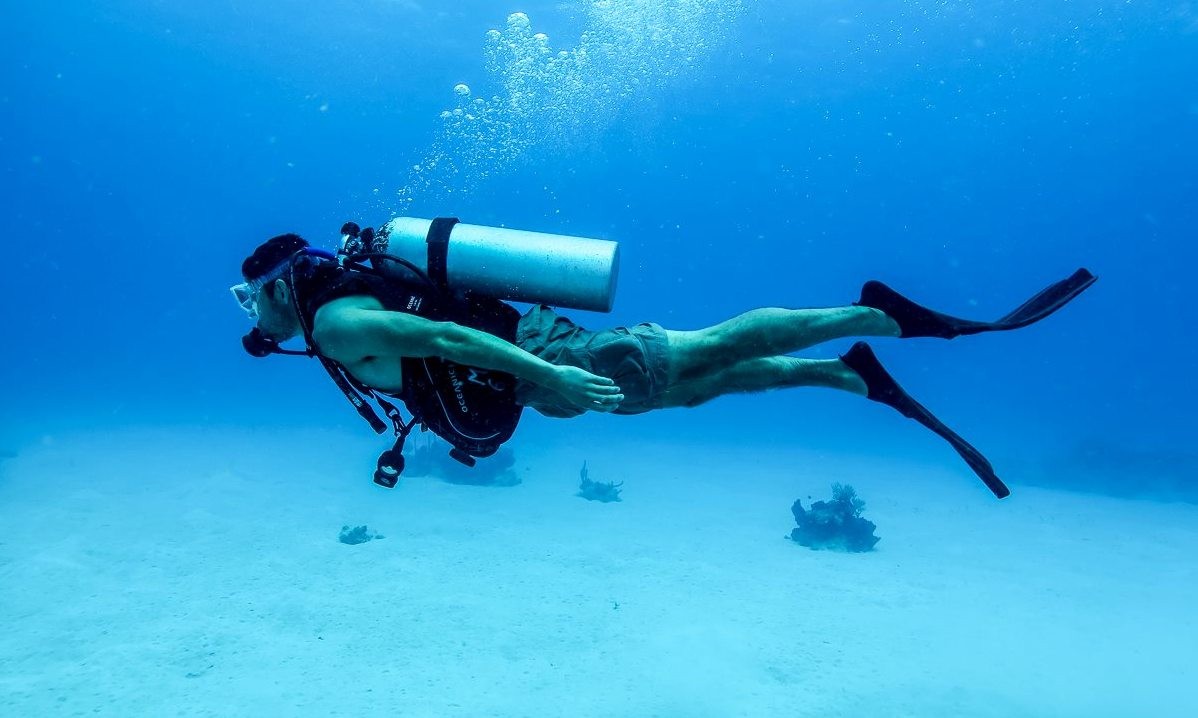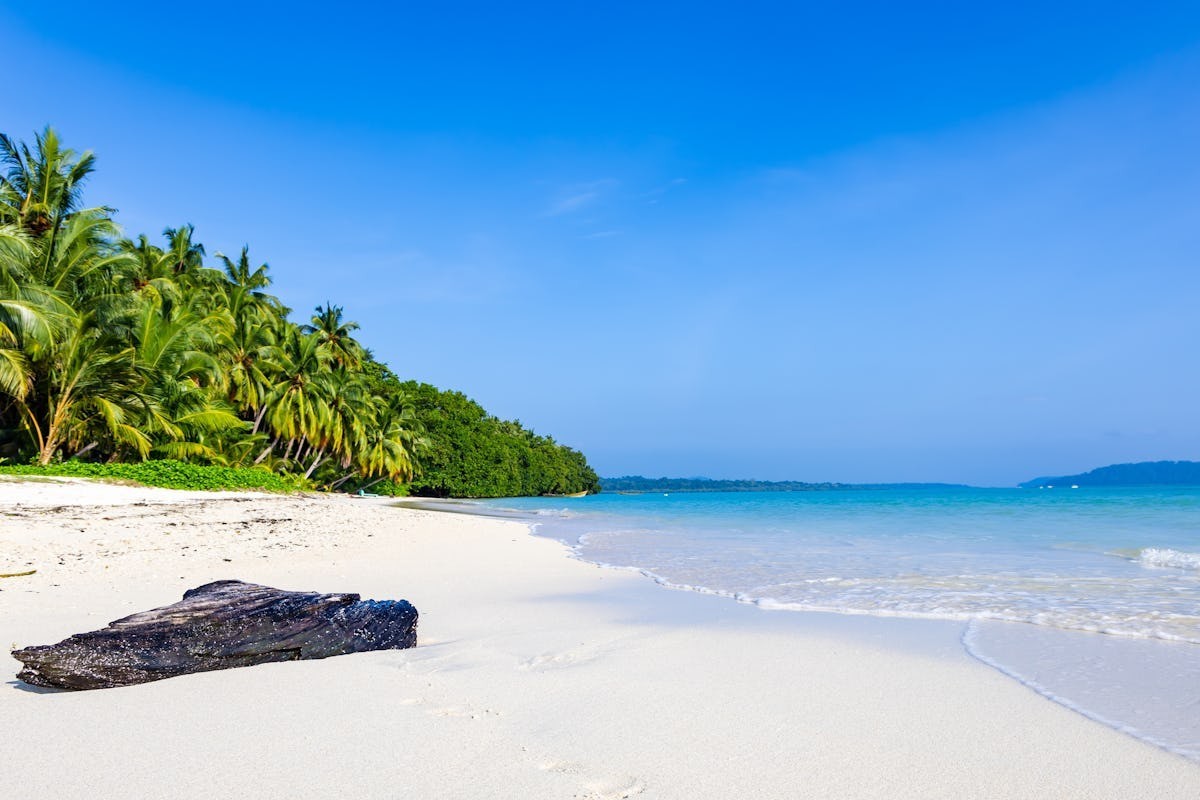Diving Sites in Port Blair




-
Aug 08, 2022
The Andaman Islands, the most gorgeous union territory of India, is home to the richest marine life in the country. Here, one can see a myriad of aquatic creatures under the waves. To do that, scuba diving is the best way, which is also the most popular water sport activity across the world. The island is popular for its beachy vibes, relaxed ambience, and scrumptious seafood. Along with that, scuba diving is something that one should definitely try here.
In the Andamans, you can witness one of the densest ecosystems of coral reefs and formations. Long stretches of reefs enclose most of the islands. These reefs are usually several hundred meters wide and separated by the shore with shallow waters. Sometimes, volcanic lava hills also complement them due to which, the diving experience becomes even more amazing.
The Andamans is known for its untouched, alive corals that are home to some of the most incredible sea-dwellers. Imagine hovering inside the water while vibrant fishes are swimming with you. Exceptional, right, Thanks to the Andaman Administration that provides protection to the waters of the island. As a result, the corals and fish are abundant here and they leave you spellbound for sure. Experience the finest scuba diving while holidaying in the Andaman Islands
Factors Affecting Scuba Diving
The Andamans has around ten splendid islands that are home to over forty places to dive. However, the following factors affect the perfect diving experience:
- Safety
- Weather
- Water Depth
- Water Current
- Fish Population
- Clarity of water
- Population of Corals
Top Locations for Scuba Diving in the Andamans
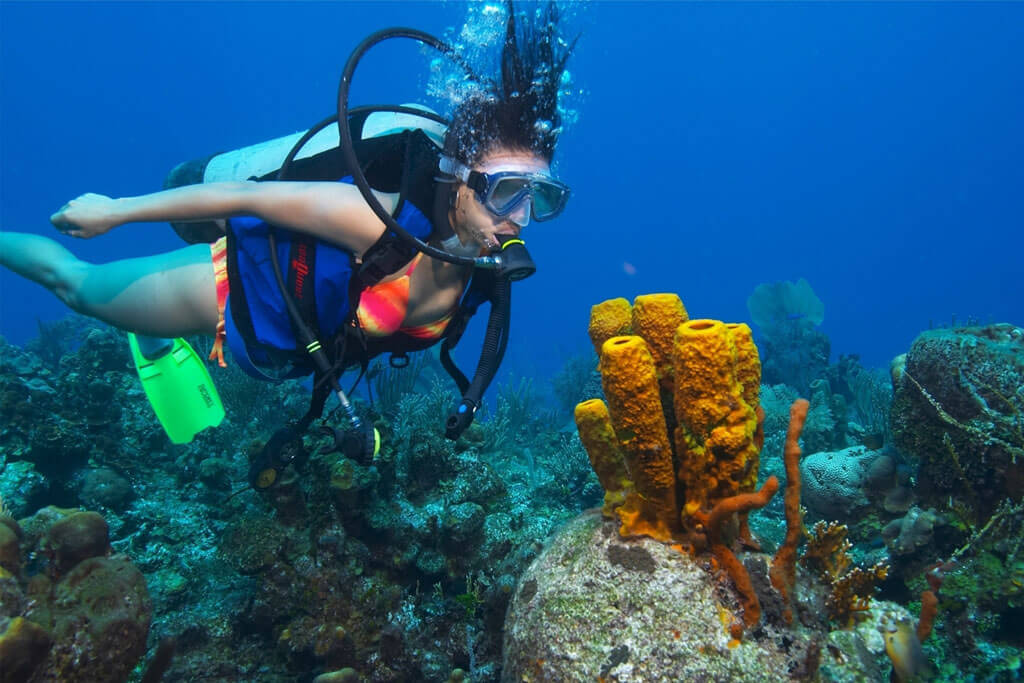
Whenever picking a place for scuba diving, one should keep the above-mentioned factors in mind. Considering all these factors, we present here the best locations for diving in the Andaman Islands. The top four islands are:
- Havelock Island (now known as Swaraj Dweep officially)
- North Bay Island
- Neil Island (now known as Shaheed Dweep officially)
- Port Blair (the capital town of the Andaman and Nicobar Islands)
- Barren Island
Diving in Havelock Island (Swaraj Dweep)

Considering all the factors impacting a perfect diving experience, Nemo Reef in Swaraj Dweep is the topmost location for scuba. Whether you are a first-timer or an experienced diver, this location is ideal for everyone. It has a rich marine life and an abundant coral population offering a jaw-dropping experience. Throughout the dive, you will be surrounded by fishes and other sea dwellers. Scuba diving at Nemo Reef is a stress-free and safe experience because the water currents here are low and the visibility is also good.
We, at Dive Andaman, make sure that everyone has a great diving experience. We are a 5-star PADI facility located in Havelock Island where you can book your fun diving or take up any diving course.
Top Scuba Diving locations in Havelock Island
Based on different types of experience, Havelock Island has a total of nine spots that offer a great diving adventure.
Barracuda City
For beginners, this is simply the best spot for diving. It is completely different from other locations as you can see long strips of coral belts with the perfect blend of hard as well as soft coral population. Its rich ecosystem offers tons of fish of diverse species and colors. And if you are lucky enough, then you can spot wandering sea turtles near the corals. If you are seeking a highly unique and terrific experience, then Barracuda City is the perfect spot for you.
Turtle Bay
As evident from the name, Turtle Bay has plenty of sea turtles. Moreover, you can also spot corals and Rays in abundance here. This spot is perfect for you if you are a true lover of natural marine life. The depth of water doesn’t exceed fourteen meters, thus making it a decent destination for inexperienced divers. Overall, you can definitely pick this spot for your first diving experience.
Seduction Point
A huge underwater rock displaying an ample range of marine life is what describes this hilly underwater world the best. Divers looking for something exclusive should know that this is a perfect diving spot in Havelock Island owing to the shallow water, a large number of inhabitants including Napoleons, and a dense population of hard staghorn corals.
Mac Point
Popular for hard corals and small groups of fish, you can reach this place by boat. The capital animal of Andaman- Dugong, which is also known as sea-cow, can be easily spotted here. Hands down, this is a great diving spot for beginners as well as experienced ones.
Promising a lot to beginners, this spot is a bit offshore at a distance of three kilometers from the Elephant Beach. It houses fringing reefs that are crowded with large groups of colorful fishes. You can see hard corals here in its clear water that is perfect for a good view of marine life.
The Wall
Allowing for a very unique view of the underwater world, this is a huge underwater rock that drops down to 56 meters. If you want to have an extraordinary diving experience in Andaman Island, then The Wall is a great place, which is covered with soft corals and a highly rich marine life.
Minerva Ledge
It is simply described as an enormous block of hard corals in clear waters, with sea dwellers including sharks. The site is only recommended for experienced divers. It promises a rare glimpse of the underwater kingdom along with an enthralling diving experience.
Pilot Reef
Only recommended for experienced divers, this is a long strip of the underwater canyon, which is nearly 24 meters deep. It is known for having abundant hard corals along with unique fish such as leopard and whitetip sharks among others.
Lighthouse
If you want to witness the perfect balance of vibrant fish and soft & hard corals, then this is your one-stop destination. The water is shallow but gets deeper as you move farther from the shore. You can dive here at night also since the water clarity is great here.
Other top Scuba Diving Sites in Havelock Island
- M4
- Jackson’s Bar
- Jonny George
- Broken Ledge
- Dicksons Pinnacle
- Whitehouse Rock
- MV Mars
- Red Pillar
- The Slope
- Purple Haze
- S.S. Inchkett
Diving in North Bay Island

A tiny island located near Ross Island, North Bay is the second-best destination for scuba diving in the Andaman and Nicobar Islands. Its waters are crystal clear and cobalt blue that are perfect for spotting vibrant fish and colourful corals. Thus, a wonderful diving experience is guaranteed. As compared to any other location in the Andamans, the diving prices here are low. However, the boat and transportation charges may be more. So, it is recommended that you book your dive in advance. North Bay is a small island and people especially come here for the scuba diving experience only. You can spend an entire day here enjoying your dives.
Diving in Neil Island (Shaheed Dweep)
In India, Andaman Island is the best place that provides scuba diving experience and certification courses. Of all the places, Neil Island has the most advanced scuba diving facilities. The crystal-clear water of its beaches makes underwater sighting even easier. The experience of scuba diving in Neil Island is a memorable one. The underwater marine life surrounds you so closely that you can literally touch it (but you are not supposed to!). The resorts on this island offer scuba training and gear lending as per your requirements.
The best time to visit Neil Island is from October to April when the weather is pleasurable. Most of the people preferring to come here plan their Andaman trip during this time. It is located at a distance of 30 kilometres from the main islands of the Andamans and is known for some of the most unique sights.
Top Dive Sites in Neil Island
- Rocky’s
- Junction
- Bus Stop
- Busy Burro
- Lighthouse
- Margherita
- Nursery/One Bottle
- Aquarium/Neil Garden
- Manta Point/Robin’s Bay
Diving in Port Blair (capital city of the Andaman and Nicobar Islands)

The miraculous natural marine life under the enchanting waters of Port Blair is waiting for you. Scuba diving is the best water activity in the world, and doing it for the first time here would be an experience of a lifetime for you. Whether you are a swimmer or a non-swimmer, this activity is an excellent option for you. To enjoy it to the fullest, always listen to your instructor and follow his instructions. The capital city is also popular for its rich history and natural beauty. It boasts of a number of spellbinding tourist-friendly places that are gorgeous and awe-inspiring.
When in Port Blair, one can go scuba diving at any of these places:
Great Places for Scuba Diving in Port Blair
- Corbyn’s Cove Beach
- Mahatma Gandhi Marine National Park
- Corruption Rock
- Rutland Island
- Snake Island
Diving in Barren Island
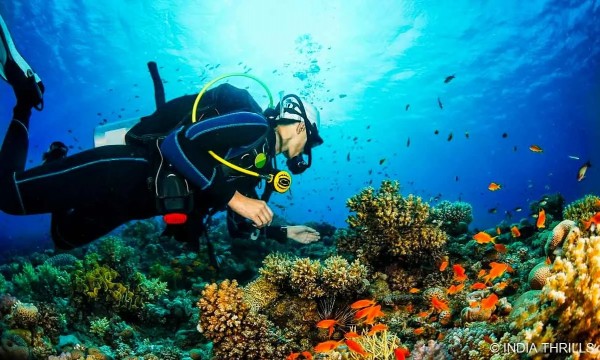
The extraordinary underwater world of Barren Island comprises silver garden eels, dolphins, white-tip reef sharks, turtles, etc. If you are lucky, then you can also spot large manta rays spanning up to 6 meters as well. However, diving here is quite costly and requires more time for commuting. Usually, November to February is considered the best time to visit this island. The weather is clear during these months giving a good possibility to see the island and the volcano.
If you want to see something extraordinary, then don’t forget to include Barren Island in your travel itinerary. Located in the Andaman Sea, the Barren Volcano is the only confirmed active volcano in South Asia. Also, along a chain of volcanoes from Sumatra to Myanmar, this is the only active volcano. It is located nearly 138 kilometres from Port Blair. If it’s a lucky day and if you are also fortunate enough, then you can see the volcano erupting lava and ash. Its first eruption was recorded in 1787.
Cost of Scuba Diving in the Andamans
The cost of scuba diving in the Andaman Islands depends on the location where you are diving. Also, if you are doing boat diving, then it will add to the price. Considering all the factors, Havelock Island is the topmost location and the most affordable also for scuba diving on the island. At Dive Andaman, you can book your dive after choosing from different options.
Scuba Diving Prices and Trips
Anyone can cherish the joy of scuba diving in the Andaman Islands. Our PADI-certified instructor will be there with you at every step and makes sure that you are learning diving skills along with having fun as well. You will learn the basics and dos and don’ts of scuba diving from him.
Below is the table of scuba diving prices in the Andamans:
Scuba Diving for Non-Swimmers
| S.no. | Dive Type | Cost (in Rs.) |
| 1. | Pool DSD Confined practice | 2,000 |
| 2. | PADI Discover Scuba Diving Program (Boat) | 6,500 |
| 3. | PADI Discover Scuba Diving Program (Shore) | 4,500 |
| 4. | Guided Snorkelling | 2,500 |
| 5. | Guided Snorkelling (Boat) | 4,000 |
Scuba Diving for Beginners Swimmers
| S.no. | Dive Type | Cost (in Rs.) |
| 1. | PADI Scuba Diver Course | 20,000 |
| 2. | PADI Open Water Course | 28,000 |
| 3. | PADI Open Water Course (Referral Diver) | 16,000 |
| 4. | PADI Advanced Open Water Course | 25,000 |
| 5. | PADI Emergency First Aid Responder Course | 10,000 |
| 6. | PADI Rescue Course | 22,000 |
| 7. | PADI Dive Master Course | 70,000 |
Speciality Dive Courses for Divers & Professionals
| S.no. | Dive Type | Cost (in Rs.) |
| 1. | Wreck Dive Speciality | 16,000 |
| 2. | Drift Dive Speciality | 16,000 |
| 3. | Underwater Naturalist Speciality | 14,000 |
| 4. | Underwater Navigation Speciality | 14,000 |
| 5. | Underwater Photograph Speciality | 19,000 |
| 6. | Peak Performance Buoyancy Speciality | 14,000 |
| 7. | Night Dive Speciality | 15,000 |
| 8. | Project AWARE Speciality (classroom session) | 6,000 |
| 9. | Deep Dive Speciality | 12,000 |
| 10. | Boat Dive Speciality | 10,000 |
| 11. | O2 Provider Speciality (classroom session) | 10,000 |
Getting a Diving Certification in the Andaman Islands
If you are interested in becoming a licenced or professional scuba diver, then Dive Andaman offers a wide range of PADI certifications. Beginners have to take up the basic Open Water Course and complete it to get the diving card. One is eligible to dive at basic dive sites around the world after this.
If you are really serious about scuba diving and want to become an instructor, then you should apply for an Advanced Open Water course. After completing this course, you can dive up to a depth of 30 meters. You will become an Emergency Responder by continuing this course. Going further, you will become a PADI Rescue Diver and then a Dive Master. Having a Dive Master certification means you can assist new divers around the globe.
Frequently Asked Questions About Scuba Diving
Question 1: Will I have a guide under the water?
Answer: Of course. You will have an experienced dive instructor at all times under the water.
Question 2: How deep will I dive?
Answer: The certification depth limit of your dive group will decide the depth of your dive (Scuba Diver 12 meters, Open Water 18 meters, Deep Adventure Diver, and Advanced Open Water 30 meters). The depth also depends on the site (some are not deeper than 16 meters). Efforts are made to keep divers with similar depth limits together. The first two dives of the PADI Open Water Diver Program are a maximum of 12 meters and the next two are 18 meters (12 meters for 10-11 years olds). The dives will be more than 5 meters and you do not have to go 18 meters in the beginning. In case you are anxious, then talk to your instructor.
Question 3: How long do I need to wait until I fly?
Answer: After your last dive, you must wait for 18 hours before flying.
Question 4: Can I still dive in case I have lost my certification card?
Answer: The staff at the PADI dive shop will look you up on the database if you hold a PADI certification. In case you hold a certification with another body like SSI, NAUI, TDI, CMAS, BSAC, etc., then you will have to show your logbook and complete a liability disclaimer form.
Question 5: Can I bring my own underwater camera/go pro?
Answer: Yes, you can bring your own camera. However, you will be expected to practice good buoyancy control as well as act responsibly around marine life. You will be required to put the camera away if you hold onto coral, kick up sand, lose control of your buoyancy, chase or disturb aquatic life. There may be significant penalties for habitat destruction and harassing marine life.
Question 6: I wear eyeglasses. Can I still dive?
Answer: Of course. One way is to dive by wearing daily disposable contact lenses as these are best in case you lose any one or both of them under the water. And if you are not a contact lens wearer, then a prescription mask is your best bet. You will find such masks at some dive shops but it is not sure that you will find one that matches your eyesight requirements exactly. So it is recommended that you invest in one of your own. If you are long-sighted, which means you have difficulty in reading but are okay with distances, then you can buy prescription stickers that you can apply to the lower section of a regular mask. It is like wearing reading glasses.
Question 7: Will there be dangerous marine life?
Answer: This completely depends on your diving spot and what you understand by ‘dangerous’. Some areas have corals and plants that may sting if you brush up against them. Most aquatic animals do not attack and have stingers only for defending themselves. Interacting with marine life is a skill and your instructor will explain it to you. You will have great encounters with various amazing species while scuba diving, but the golden rule is not to touch anything under the water. You are entering their environment and poking them is definitely inappropriate.
Question 8: Will there be a problem if I am not a strong swimmer?
Answer: To learn scuba diving, you don’t need to be Michael Phelps However, there are some minimum requirements for safety reasons. You will have to complete a 200-meter swim (any stroke and it is not timed), float for 10 minutes (laying on your back, swimming, or treading), and complete some snorkelling skills. Basically, you should comfortable in the water. In case you are not ready, then take a couple of swim classes so that you can boost your confidence and overall enjoyment.
Question 9: What is the duration of the PADI Open Water Diver course?
Answer: This totally depends on you and the dive centre, but generally it takes 3-4 days. Learning to dive is based on your skills. So the course duration is determined by your progress in the development of your skill level, confidence, and comfort. The amount of time needed at the dive centre will be reduced in case you opt for PADI eLearning prior to your program. You can take the theory and pool sessions at home and make the open water dives while vacationing If you don’t want to study on holiday. You will be given a referral document by your instructor to take with you. there are some dive centres that offer programs over a duration of 2 weekends so that you don’t have to take time off work. Thera are a number of ways but if you have decided to take the program while holidaying somewhere, then you need at least 18 hours after scuba diving before flying anywhere.
Question 10: Will it be safe if I go scuba diving in the Andaman Islands?
Answer: If you enjoy sound health and do not have any medical complications, then you can go scuba diving. You will have to attend a training session with licensed divers before you dive into the ocean. The best quality scuba equipment will be given to you. Moreover, an expert trainer will accompany you throughout your dive.
Question 11: Do I need to carry something while going scuba diving in the Andaman Islands?
Answer: While going for this incredible water sport, you need to carry a few things with you. Just put these in a bag and leave it outside the water. Once your diving session is done and you are out of the water, you may need these.
The things to carry are as follows:
- Towel
- Bottle of water
- Extra set of clothes
- Personal medicine kit
Question 12: Which is the best place for scuba diving in the Andamans?
Answer: There are more than 40 places to dive into this Indian union territory. Various factors that influence the perfect diving experience are mentioned below:
- Safety
- Weather
- Water depth
- Water current
- Fish population
- Clarity of water
- Population of corals
Havelock Island is the best island for exploring the rich marine life of the Andaman Islands via scuba diving. Apart from that, there are so many other water sports also that one can try here. Havelock Island is the hub of adventure activities on the island.
Diving Sites in Port Blair
Diving Sites in Havelock Island
Diving Sites in Neil Island
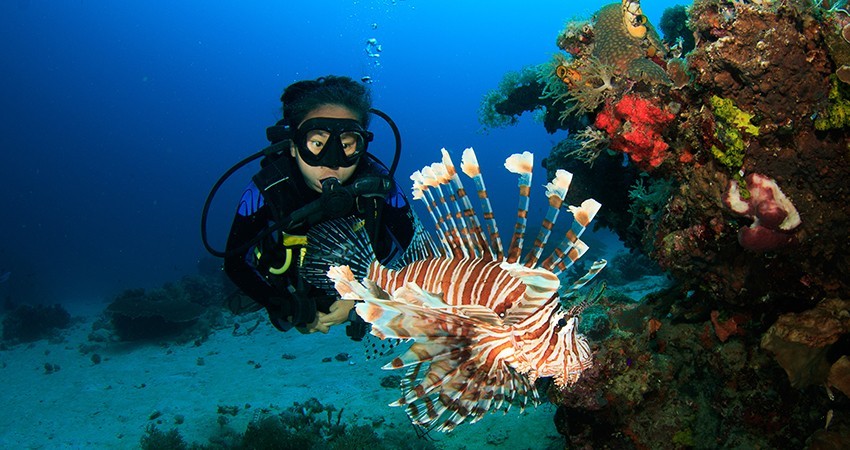
.jpg)

